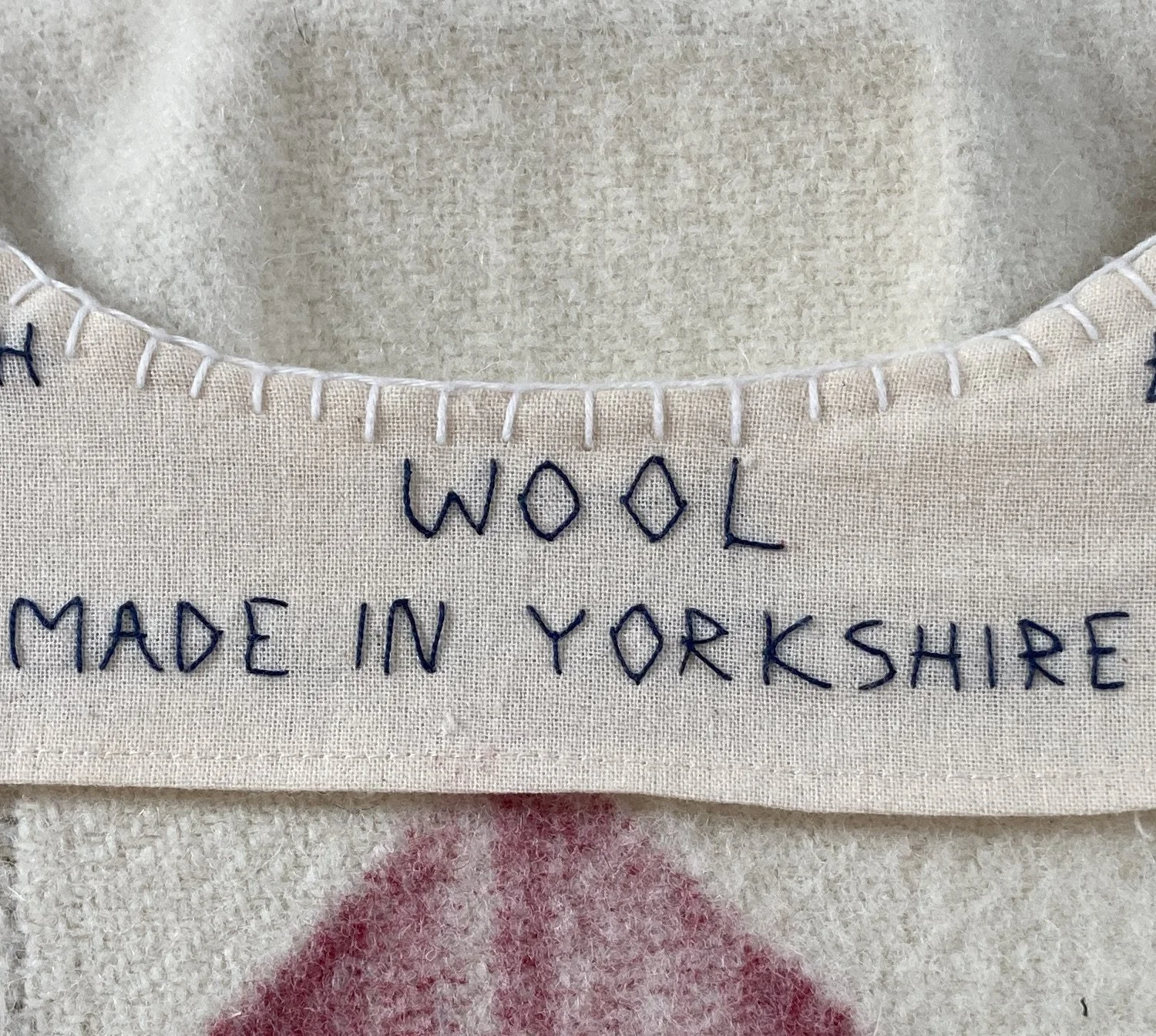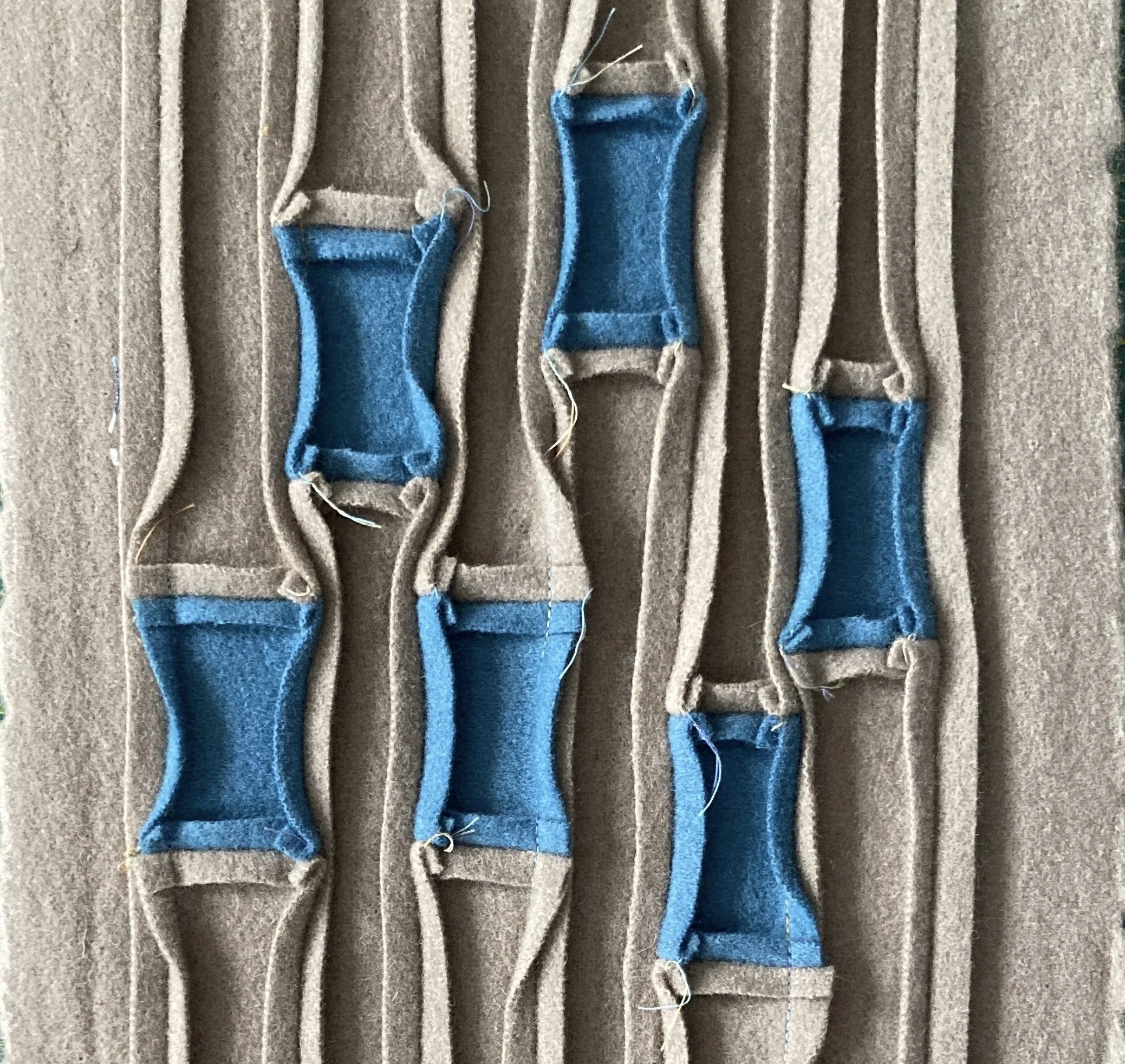Waste from Waste
This project has been about using the scraps of cloth that are inevitably part of the production process at the A W Hainsworth woollen mill. I have used those scraps to make new fabric, but of course there are smaller scraps from those scraps. This is some of the waste from my project – there are bigger leftover pieces, some of which I have plans for but these are ones that I am still thinking about.
Clockwise from the top left:
Trimmings from the blanket fabric – mostly from straightening edges
Trimmings from the lovely felted wools, most of these are from deciding to work with 2 inch squares after I had cut my pieces to 2.25 inches!
More larger blanket trimmings plus the rescued cotton(?) thread that was used to join the blankets as part of the fulling process – I have used a length of this in the Coat. Also in the background, the end of a blanket strip with its factory batch label – which is glued VERY firmly.
And a colourful array of fluff from inside the embellisher machine, this has been described as ‘print flock’ – I think that means I could lay it over a glue-print design.
So what to do with this waste?
I shall explore using the embellisher machine with some of the colourful strips – I have quite a lot of those and a number of offcuts of the blanket wool, as well, of course plenty of other scraps in my stash. At the moment the colourful flock from the embellisher is sitting on my desk looking beautiful with its rich colours, maybe one day I will find a use.
I wondered what normally happens to the waste from Hainsworth Mill, and went down a rabbit hole reading about the shoddy industry. Of course, there is waste at every stage in the textiles process, which begins at Hainsworth with the mixing of fibres before spinning them into threads which are then woven into cloth. There will be dust and fluff which is removed from the air to protect the lungs of workers, ends of yarn and the scraps of cloth such as we have been using.
In her book Shoddy: from devil’s dust to the renaissance of rags, Hannah Rose Shell describes the history of the industry from its beginnings in West Yorkshire in the 19th Century (2020). She begins with considering what happens to clothing that nobody wants to buy from the charity shop, and from there discovered the word shoddy as used in the context of textiles.
Shoddy is Woollen yarn obtained by tearing to shreds refuse woollen rags, which, with the addition of some new wool, is made into a kind of cloth (OED, 2022).
‘Forced’ rhubarb growing in one of Oldroyd’s sheds (February 2018)
Shell visited the Rhubarb Triangle and discovers that waste from the shoddy process is used as a fertiliser – waste wool is high in nitrogen it is a great addition to the soil. According to the Yorkshire Post in 2014, one of the largest rhubarb producers in Yorkshire, Oldroyds, uses wool waste from A W Hainsworth, (Ransley, 2014).
The last shoddy mill in Yorkshire closed down in 1995, although rags reprocessing continues – with clothing from across the UK’s charity shops being sorted in Europe and then returning to West Yorkshire for shredding and being put to a variety of uses including mattress padding and carpet underlay. Of course this material is no longer wool – most clothing that goes for shredding will not be made from wool.
The shredding of textiles for other uses explains the strange material I have noticed being used on York Racecourse (left).
This seems to be a mixture of shredded fabric, carpet and hair. It is used on the racetrack where it is crossed by a road.
Shoddy processing returns to Yorkshire in 2022
Over the last few years the business iinouiio has been trying to resurrect the shoddy business in Yorkshire. This year it was announced that they have gone into partnership with another Yorkshire textile business, Camira, which helps to bring a more circular economy to the textiles industry in the region.
References
Ransley, J. (2014) ‘Deep inside Yorkshire’s rhubarb triangle’, Yorkshire Post, 15 February. Available at: https://www.yorkshirepost.co.uk/lifestyle/food-and-drink/deep-inside-yorkshires-rhubarb-triangle-1846044 (Accessed: 19 May 2022).
Shell, H.R. (2020) Shoddy: from devil’s dust to the renaissance of rags. Chicago: University of Chicago Press.
OED, (2022) Shoddy online at https://www.oed.com/view/Entry/178430















